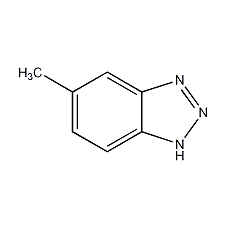
Structural formula
| Business number | 03R3 |
|---|---|
| Molecular formula | C7H7N3 |
| Molecular weight | 133.15 |
| label |
5-Methyl-1H-benzotriazole, 5-methylbenzotriazole, m-tolylhydrazide, m-azidotoluene, Methylbenzotriazole, 5-methylphenyltriol, 5-methylbenzotriazole, 5-Methyl-1H-benzo-1,2,3-triazole, 5-methyl-1h-benzotriazol, m-Tolylazoimide, Retrocure G, aromatic compounds |
Numbering system
CAS number:136-85-6
MDL number:MFCD00005702
EINECS number:205-265-8
RTECS number:DM1400000
BRN number:116658
PubChem number:24851750
Physical property data
1. Physical property data
1. Properties: light brown powder.
2. Density (g/mL, 25/4℃): Uncertain
3. Relative vapor density (g/mL, air=1): Uncertain
4. Melting point (ºC): 82.83
5. Boiling point (ºC, 0.67kpa or 5 mmHg): 201-204
6. Refractive index: Uncertain
7. Flash point (ºC): Uncertain
8. Specific rotation (ºC): Uncertain
9. Autoignition point or ignition temperature ( ºC) Uncertain
10. Vapor pressure (kPa, 25ºC): Uncertain
11. Saturated vapor pressure (kPa, 60ºC): Uncertain
12. Heat of combustion (KJ/mol): Uncertain
13. Critical temperature (ºC): 50.3
14. Critical pressure (KPa): Uncertain
15. The logarithmic value of the oil-water (octanol/water) partition coefficient: Uncertain
16. The upper limit of explosion (%, V/V): Uncertain
17. Explosion Lower limit (%, V/V): Uncertain
18. Solubility: Easily soluble in methanol, acetone, cyclohexane, ether, etc., but insoluble in water and petroleum solvents. The aqueous solution is slightly acidic, with a pH value of 5.5 to 6.5. It is stable to acids and alkalis, and can form stable metal salts with alkali metal ions.
Toxicological data
Acute toxicity data:
Oral LD50 in rat: 1600mg/kg
Dermal LD50 in guinea pig: >1mg/kg
Ecological data
General Notes
Water HazardsCategory 1 (German Regulation) (self-assessment via list) The substance is slightly hazardous to water.
Do not allow undiluted or large amounts of product to come into contact with groundwater, waterways or sewage systems.
Do not discharge materials into the surrounding environment without government permission.
Molecular structure data
Molecular property data:
1. Molar refractive index: 39.53
2. Molar volume (cm3/mol): 104.5
3. Isotonic specific volume (90.2K): 296.6
4. Surface tension (3.0 dyne/cm): 64.7
5. Polarizability (0.5 10-24cm3): 15.67
Compute chemical data
1. Reference value for hydrophobic parameter calculation (XlogP): 1.4
2. Number of hydrogen bond donors: 1
3. Number of hydrogen bond acceptors: 2
4. Number of rotatable chemical bonds: 0
5. Number of tautomers: 3
6. Topological molecule polar surface area 41.6
7. Number of heavy atoms: 10
8. Surface charge: 0
9. Complexity: 126
10. Number of isotope atoms: 0
11. Determine the number of atomic stereocenters: 0
12. Uncertain number of atomic stereocenters: 0
13. Determine the number of chemical bond stereocenters: 0
14. Number of uncertain chemical bond stereocenters: 0
15. Number of covalent bond units: 1
Properties and stability
Storage method
None
Synthesis method
1. Similar to the production method of benzotriazole, it can be obtained by diazotization and cyclization of toluenediamine. An older method is obtained by reacting m-toluidine diazonium salt with p-toluenesulfonamide
2.Diazotize toluenediamine, cyclize it in acetic acid, and then distill it under reduced pressure to obtain crude methylbenzotriazole, which is then recrystallized, refined, and dried. Pure methylbenzotriazole can be obtained. There is also a method to produce relatively pure methylbenzotriazole without distillation using methyl o-phenylenediamine and ethylhexyl nitrite as raw materials and ethylhexanol as the solvent.
Purpose
As a corrosion inhibitor for copper and copper alloys, this product is similar to benzotriazole (BTA). Actual products also include 4-methylbenzotriazole ([29878-31-7]) or both. mixture, referred to as TTA. Benzotriazole corrosion inhibitors can form insoluble stable complexes with cuprous ions, which are adsorbed on the metal surface to form a stable and inert protective film with a thickness of only 5×10-7cm, but in various It is very stable in this medium, thus protecting the copper alloy. BTA’s corrosion inhibition effect is limited to within the pH range of 5.5-10, but in low pH media, TTA’s corrosion inhibition effect is stronger than BTA. Other triazole compounds, such as triazole and naphthotriazole, also have corrosion inhibition effects on copper and copper alloys, but not as well as BTA and TTA. Methylbenzotriazole is also used in organic synthesis.
Methylbenzotriazole has a corrosion inhibition effect on copper and copper alloys. It can be combined with other organic corrosion inhibitors or alone Add. The usage concentration of methylbenzotriazole is 2 to 10mg/L.

 微信扫一扫打赏
微信扫一扫打赏

